Economic Insights
Trends in RRSP Contributions and Pre-retirement Withdrawals,
2000 to 2013
Archived Content
Information identified as archived is provided for reference, research or recordkeeping purposes. It is not subject to the Government of Canada Web Standards and has not been altered or updated since it was archived. Please "contact us" to request a format other than those available.
by Derek Messacar,
Social Analysis and Modelling Division, Statistics Canada
Start of text box
This article in the Economic Insights series presents an overview of recent trends in registered retirement savings plan (RRSP) use among Canadian taxfilers aged 25 to 54, from 2000 to 2013. The analysis centres on differences in RRSP contribution and withdrawal behaviour across income groups, and around the time that the tax‑free savings account (TFSA) was introduced. Overall, the analysis shows that the flow of funds into RRSPs has declined in recent years.
End of text box
Introduction
Registered retirement savings plans (RRSPs) are a tax-preferred (offering tax advantage) savings vehicle designed to—as the name suggests—encourage individuals to save for retirement. Since contributions to these accounts are made on a pre-tax basis, the tax advantage of using RRSPs largely depends on the marginal tax rate of the contributor (Veall 2001). However, RRSPs are also used for other reasons, as evidenced by the frequency of RRSP use by low-income individuals (Frenken 1997) and the correlation of pre-retirement withdrawals with events such as divorce or separation, job loss, or the death of a spouse (Mawani and Paquette 2011). Previous studies have found that approximately one dollar is withdrawn from RRSPs before retirement for every five dollars contributed in the same tax year (Akyeampong 1998; Giles and Maser 2004).
The aim of this article is to document recent trends in RRSP contributions and withdrawals, from 2000 to 2013, for individuals aged 25 to 54, based on an analysis of tax data from Statistics Canada’s Longitudinal Administrative Databank (LAD).Note 1 In particular, the analysis will focus on differences in use across individuals with different levels of income. Frenken (1997) notes that there is little motivation for taxfilers with lower incomes to contribute to RRSPs, but many of them do so anyway. Yet this behaviour may have occurred simply because, for a long time, RRSPs were the only widely available savings vehicle with tax advantage for individuals not covered by employer-sponsored pension plans. The introduction of tax-free savings accounts (TFSAs) in 2009 provided a new means of tax-preferred saving for Canadians with different incentives to contribute based on their levels of income. Hence, this article will also consider how RRSP use changed for various income groups around the time TFSAs were introduced.
Trends in the use of RRSPs and TFSAs
Chart 1-1 shows the number of RRSP contributors and withdrawers among 25- to 54-year-olds from 2000 to 2013. Several trends are interesting to note. First, the number of contributors declined gradually by approximately 16% over this period, from 5.0 million in 2000 to 4.2 million in 2013. Two of the largest annual declines occurred from 2007 to 2008 (2.8%) and from 2008 to 2009 (4.4%), which coincided with both the economic recession in 2008/2009 and the introduction of TFSAs in 2009. The total number of taxfilers aged 25 to 54 in the sample increased by 3.2% over the relevant period, so these trends are not simply the result of changing demographics.
Second, the number of RRSP withdrawers (total withdrawers) increased over the period, from approximately 0.9 million in 2000 to 1.3 million in 2013. This analysis delineates individuals based on whether they withdrew directly from financial institutions, or indirectly by defaulting on a Home Buyers’ Plan (HBP) repayment. While the number of total withdrawers increased, the number of direct withdrawers remained stable, even through the recession, which suggests rising HBP use and/or an increase in HBP defaults.Note 2 It is worthwhile to note that some individuals both contribute to an RRSP and default on an HBP repayment (by not designating their RRSP contribution as a repayment) in the same year. This behaviour has no effect on tax liability, as the RRSP contribution is tax-deductible and offsets the income inclusion of the missed HBP repayment, but it has the effect of decreasing available RRSP contribution room.
Third, the slight decline in RRSP use over the last few years coincided with an increase in the number of individuals aged 25 to 54 who contributed to a TFSA, from 2.0 million in 2009 to 3.0 million in 2013. However, while the number of TFSA contributors has risen, so has the number of withdrawers. In 2013, there were approximately 1.6 million TFSA withdrawers, slightly more than one-half the number of contributors in that year.
The estimated flows of funds into and out of RRSPs are shown in Chart 1-2. Consistent with the downward trend in the frequency of contributing, the total value of RRSP contributions also declined steadily over the period among 25- to 54-year-olds, from approximately $30.6 billion to $22.5 billion (measured in 2013 constant dollars). In contrast, total withdrawals have remained relatively stable since 2000. Despite the prevalence of HBP defaulters shown in Chart 1-1, defaults represent only approximately 5% to 10% of total withdrawals because the values of HBP defaults are comparatively low. This occurs because the maximum amount that individuals could borrow from their RRSPs over most of the sample period was $20,000, and the repayment period was 15 years, so annual defaults would be approximately $1,350 at most.Note 3
Chart 1-2 also shows that contributions to TFSAs have increased recently, from approximately $9.0 billion in 2009 to $15.9 billion in 2013 (measured in 2013 constant dollars). The extent to which this trend represents a redistribution of savings contributions from RRSPs or other savings vehicles to TFSAs is unclear, and is discussed in more detail below. However, the value of TFSA withdrawals also increased, from $1.3 billion in 2009 to $7.4 billion in 2013. Approximately $0.47 was withdrawn from TFSAs in 2013 for every $1.00 contributed in that year. Hence, both the frequency and magnitude of TFSA withdrawals are significantly larger than for RRSPs.
To further explore the distributions of RRSP use, Charts 2-1 and 2-2 show the 10th, 25th, 50th (median), 75th and 90th percentiles from the distributions of RRSP contributions and withdrawals, respectively, in 2013 constant dollars. For example, Chart 2-1 shows that the median RRSP contribution in 2013 was $2,650, whereas the 90th percentile of contributions was $13,750. In general, these charts indicate that the majority of contributions and withdrawals are small, but there are still non-trivial shares that are large and count significantly toward the aggregate flows of funds into and out of these plans. There have been gradual declines in the values of both contributions and withdrawals at each reported percentile. For example, the 25th and 75th percentiles of RRSP contributions declined from $1,650 to $1,100, and from $7,500 to $6,250 respectively from 2000 to 2013. Similarly, the 25th and 75th percentiles of RRSP withdrawals fell from $850 to $350 and from $6,800 to $3,500 respectively over this period.
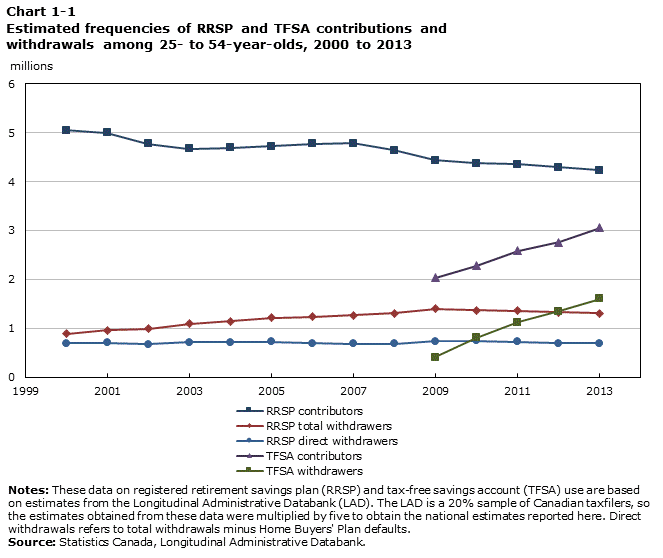
Description for Chart 1-1
| Year | RRSP contributors | RRSP total withdrawers | RRSP direct withdrawers | TFSA contributors | TFSA withdrawers |
|---|---|---|---|---|---|
| millions | |||||
| 2000 | 5.05 | 0.89 | 0.69 | Note ...: not applicable | Note ...: not applicable |
| 2001 | 5.00 | 0.96 | 0.70 | Note ...: not applicable | Note ...: not applicable |
| 2002 | 4.77 | 0.99 | 0.67 | Note ...: not applicable | Note ...: not applicable |
| 2003 | 4.67 | 1.09 | 0.71 | Note ...: not applicable | Note ...: not applicable |
| 2004 | 4.69 | 1.14 | 0.71 | Note ...: not applicable | Note ...: not applicable |
| 2005 | 4.72 | 1.21 | 0.72 | Note ...: not applicable | Note ...: not applicable |
| 2006 | 4.77 | 1.23 | 0.69 | Note ...: not applicable | Note ...: not applicable |
| 2007 | 4.78 | 1.27 | 0.68 | Note ...: not applicable | Note ...: not applicable |
| 2008 | 4.64 | 1.31 | 0.68 | Note ...: not applicable | Note ...: not applicable |
| 2009 | 4.44 | 1.40 | 0.73 | 2.03 | 0.41 |
| 2010 | 4.38 | 1.37 | 0.74 | 2.28 | 0.80 |
| 2011 | 4.35 | 1.36 | 0.72 | 2.59 | 1.12 |
| 2012 | 4.29 | 1.33 | 0.69 | 2.76 | 1.35 |
| 2013 | 4.23 | 1.31 | 0.69 | 3.06 | 1.60 |
|
... not applicable Notes: These data on registered retirement savings plan (RRSP) and tax-free savings account (TFSA) use are based on estimates from the Longitudinal Administrative Databank (LAD). The LAD is a 20% sample of Canadian taxfilers, so the estimates obtained from these data were multiplied by five to obtain the national estimates reported here. Direct withdrawals refers to total withdrawals minus Home Buyers' Plan defaults. Source: Statistics Canada, Longitudinal Administrative Databank. |
|||||
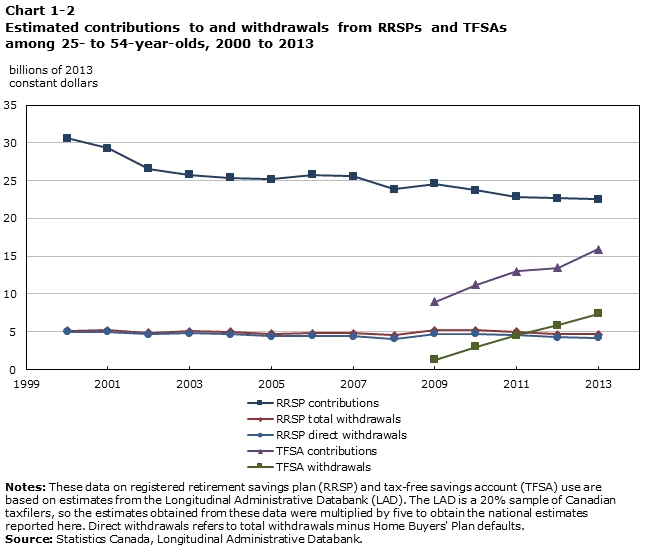
Description for Chart 1-2
| Year | RRSP contributions | RRSP total withdrawals | RRSP direct withdrawals | TFSA contributions | TFSA withdrawals |
|---|---|---|---|---|---|
| billions of 2013 constant dollars | |||||
| 2000 | 30.60 | 5.15 | 5.00 | Note ...: not applicable | Note ...: not applicable |
| 2001 | 29.25 | 5.20 | 5.00 | Note ...: not applicable | Note ...: not applicable |
| 2002 | 26.60 | 4.90 | 4.65 | Note ...: not applicable | Note ...: not applicable |
| 2003 | 25.75 | 5.05 | 4.80 | Note ...: not applicable | Note ...: not applicable |
| 2004 | 25.40 | 5.00 | 4.70 | Note ...: not applicable | Note ...: not applicable |
| 2005 | 25.20 | 4.75 | 4.40 | Note ...: not applicable | Note ...: not applicable |
| 2006 | 25.75 | 4.80 | 4.45 | Note ...: not applicable | Note ...: not applicable |
| 2007 | 25.55 | 4.80 | 4.40 | Note ...: not applicable | Note ...: not applicable |
| 2008 | 23.85 | 4.55 | 4.10 | Note ...: not applicable | Note ...: not applicable |
| 2009 | 24.55 | 5.20 | 4.75 | 8.96 | 1.32 |
| 2010 | 23.75 | 5.20 | 4.75 | 11.23 | 3.02 |
| 2011 | 22.85 | 5.00 | 4.55 | 12.98 | 4.56 |
| 2012 | 22.65 | 4.70 | 4.30 | 13.47 | 5.89 |
| 2013 | 22.50 | 4.65 | 4.20 | 15.91 | 7.40 |
|
... not applicable Notes: These data on registered retirement savings plan (RRSP) and tax-free savings account (TFSA) use are based on estimates from the Longitudinal Administrative Databank (LAD). The LAD is a 20% sample of Canadian taxfilers, so the estimates obtained from these data were multiplied by five to obtain the national estimates reported here. Direct withdrawals refers to total withdrawals minus Home Buyers' Plan defaults. Source: Statistics Canada, Longitudinal Administrative Databank. |
|||||
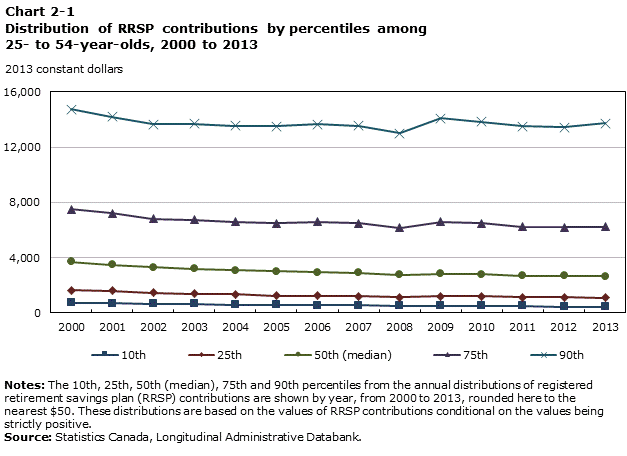
Description for Chart 2-1
| Percentiles | 2000 | 2001 | 2002 | 2003 | 2004 | 2005 | 2006 | 2007 | 2008 | 2009 | 2010 | 2011 | 2012 | 2013 |
|---|---|---|---|---|---|---|---|---|---|---|---|---|---|---|
| 2013 constant dollars | ||||||||||||||
| 10th | 750 | 700 | 650 | 650 | 600 | 600 | 550 | 550 | 500 | 500 | 500 | 500 | 450 | 450 |
| 25th | 1,650 | 1,600 | 1,450 | 1,400 | 1,350 | 1,250 | 1,250 | 1,200 | 1,150 | 1,200 | 1,200 | 1,150 | 1,150 | 1,100 |
| 50th (median) | 3,700 | 3,500 | 3,300 | 3,200 | 3,100 | 3,000 | 2,950 | 2,900 | 2,750 | 2,850 | 2,800 | 2,700 | 2,700 | 2,650 |
| 75th | 7,500 | 7,200 | 6,800 | 6,750 | 6,600 | 6,500 | 6,600 | 6,500 | 6,150 | 6,600 | 6,500 | 6,250 | 6,200 | 6,250 |
| 90th | 14,750 | 14,200 | 13,650 | 13,700 | 13,550 | 13,500 | 13,650 | 13,550 | 13,000 | 14,100 | 13,850 | 13,500 | 13,450 | 13,750 |
|
Notes: The 10th, 25th, 50th (median), 75th and 90th percentiles from the annual distributions of registered retirement savings plan (RRSP) contributions are shown by year, from 2000 to 2013, rounded here to the nearest $50. These distributions are based on the values of RRSP contributions conditional on the values being strictly positive. Source: Statistics Canada, Longitudinal Administrative Databank. |
||||||||||||||
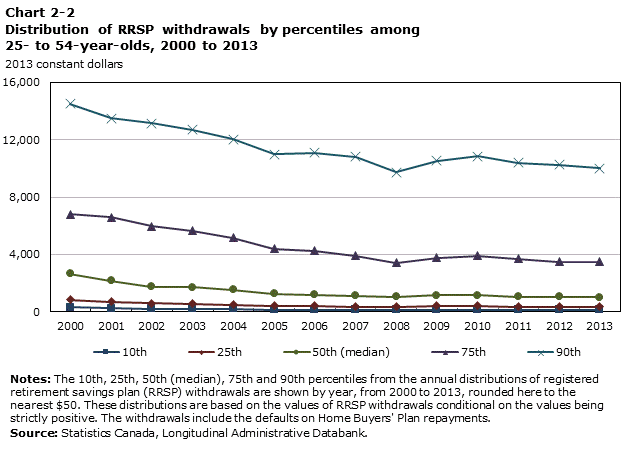
Description for Chart 2-2
| Percentile | 2000 | 2001 | 2002 | 2003 | 2004 | 2005 | 2006 | 2007 | 2008 | 2009 | 2010 | 2011 | 2012 | 2013 |
|---|---|---|---|---|---|---|---|---|---|---|---|---|---|---|
| 2013 constant dollars | ||||||||||||||
| 10th | 300 | 250 | 200 | 200 | 200 | 150 | 150 | 150 | 150 | 150 | 150 | 150 | 150 | 150 |
| 25th | 850 | 700 | 600 | 550 | 500 | 400 | 400 | 350 | 350 | 400 | 400 | 350 | 350 | 350 |
| 50th (median) | 2,650 | 2,150 | 1,750 | 1,700 | 1,550 | 1,250 | 1,200 | 1,100 | 1,050 | 1,150 | 1,150 | 1,050 | 1,050 | 1,000 |
| 75th | 6,800 | 6,600 | 5,950 | 5,650 | 5,150 | 4,400 | 4,250 | 3,900 | 3,400 | 3,750 | 3,900 | 3,700 | 3,500 | 3,500 |
| 90th | 14,500 | 13,500 | 13,150 | 12,700 | 12,050 | 11,000 | 11,100 | 10,800 | 9,750 | 10,550 | 10,850 | 10,400 | 10,250 | 10,000 |
|
Notes: The 10th, 25th, 50th (median), 75th and 90th percentiles from the annual distributions of registered retirement savings plan (RRSP) withdrawals are shown by year, from 2000 to 2013, rounded here to the nearest $50. These distributions are based on the values of RRSP withdrawals conditional on the values being strictly positive. The withdrawals include the defaults on Home Buyers' Plan repayments. Source: Statistics Canada, Longitudinal Administrative Databank. |
||||||||||||||
RRSP contributors and withdrawers
Table 1 presents descriptive statistics for all taxfilers aged 25 to 54, for RRSP contributors and for RRSP withdrawers, pooled over the years 2000 to 2013. First, this analysis shows that RRSP contributors were more often male and married, had higher earnings, and were somewhat less likely to have a child in the census family as compared with the full sample of taxfilers. The fact that fewer women contributed than men has not changed since the 1990s (Frenken 1996; 1998). In addition, contributors were more often employed, more likely to have capital gains or investment income, and less likely to collect Employment Insurance (EI) or social assistance than non-contributors. Interestingly, 50% of individuals who contributed to an RRSP also had an employer-sponsored registered pension plan (RPP) or deferred profit-sharing plan—measured by a positive pension adjustment—which suggests that the two savings vehicles are relatively complementary in practice.Note 4
| Full sample | RRSP contributors | RRSP withdrawers | ||
|---|---|---|---|---|
| Includes Home Buyers' Plan defaulters | Excludes Home Buyers' Plan defaulters | |||
| years | ||||
| Demographics | ||||
| Age | 40.1 | 40.9 | 40.8 | 41.5 |
| percent | ||||
| Female | 51.3 | 46.9 | 47.3 | 49.0 |
| Male | 48.7 | 53.1 | 52.7 | 51.0 |
| Married | 74.3 | 78.3 | 74.7 | 70.5 |
| Has a child in the census family | 64.1 | 62.2 | 65.8 | 62.3 |
| Employment and earnings | ||||
| Has employment income | 77.7 | 93.4 | 85.3 | 85.1 |
| Has self-employment income | 9.8 | 9.9 | 9.7 | 8.8 |
| Has Employment Insurance income | 13.5 | 11.1 | 17.0 | 17.4 |
| Has capital gains or investment income | 23.3 | 37.2 | 19.4 | 19.9 |
| Has social assistance income | 5.9 | 0.2 | 1.3 | 1.6 |
| Savings characteristics | ||||
| Has RRSP contributions | 40.9 | 100.0 | 41.6 | 50.8 |
| RRSP savings rate | 7.4 | 6.8 | -8.6 | -13.1 |
| Conditional employment characteristics | ||||
| Unionized | 34.0 | 37.9 | 36.1 | 34.9 |
| Has workplace pension | 39.3 | 50.0 | 45.2 | 43.5 |
| Health and disability | ||||
| Has medical or disability allowances | 12.2 | 13.3 | 13.6 | 13.6 |
| 2013 constant dollars | ||||
| Earnings characteristics | ||||
| Employment and self-employment income | 40,950 | 57,800 | 46,150 | 44,200 |
| Total income | 44,150 | 61,300 | 52,400 | 52,550 |
|
Notes: The conditional employment statistics are restricted to individuals in the sample who have strictly positive employment or self-employment income. The income estimates are averages, rounded here to the nearest $50. The groups are based on registered retirement savings plan (RRSP) use in the reference year. The RRSP savings rate is defined as the ratio of RRSP net contributions (i.e., gross contributions minus withdrawals in the reference year) to the individual’s total pre-tax income. Source: Statistics Canada, Longitudinal Administrative Databank. |
||||
Consistent with the descriptive statistics for RRSP contributors, individuals who withdrew were also more likely to be male, and to be employed, than the full sample of taxfilers. However, compared with RRSP contributors, RRSP withdrawers were less likely to be married, employed or receive capital gains or investment income; they had lower earnings and were more likely to collect EI or social assistance. These results are consistent with the findings of Mawani and Paquette (2011), who show that withdrawals often occur because of income smoothing (reducing fluctuations in income).
Excluding HBP defaulters, approximately 51% of individuals who withdrew from their RRSPs in a given year also contributed in that same fiscal year. This behaviour may occur if individuals initially over-saved and then became financially constrained, or if they chose to contribute around tax season to reduce total tax liability despite having previously withdrawn. Unfortunately, it is not possible to discern through the administrative tax records whether individuals are typically contributing or withdrawing first. On balance, RRSP withdrawers tend to “dissave” (withdraw more than is contributed), despite the prevalence of contributions occurring in the same year; this is shown by the negative average savings rate among this group.Note 5
RRSP withdrawals and tax withholding
As Frenken (1996, p. 17) notes, individuals who “dip into their RRSP savings not only reduce their future income, but also forfeit part of their savings immediately.” This occurs because RRSP withdrawals are subject to tax withholding. Withholding refers to a source deduction by the plan administrator of a portion of the withdrawal; these funds are remitted to the central tax authorities as a partial payment of the income tax owing.Note 6 Table 2 presents the withholding tax schedule as of December 31, 2013. For example, an individual residing in a province other than Quebec, who withdraws $4,000, will receive $3,600 (90% of $4,000), while $400 (10% of $4,000) will be deducted at source and remitted to the Canada Revenue Agency as an income tax payment. Across all provinces, withholding-tax rates levied on RRSP withdrawals increase above the $5,000 and $15,000 thresholds.
| Quebec | All other provinces and territories | |||
|---|---|---|---|---|
| Provincial | Federal | Total | ||
| percent | ||||
| $5,000 or less | 16 | 5 | 21 | 10 |
| $5,001 to $15,000 | 16 | 10 | 26 | 20 |
| $15,001 or more | 16 | 15 | 31 | 30 |
|
Notes: This table shows the withholding-tax rates levied on lump-sum withdrawals from registered retirement savings plans (RRSPs) by plan administrators as of December 31, 2013, across Canadian provinces. Quebec is the only province to have its own provincial withholding-tax schedule administered by Revenu Québec; all other provinces are regulated by the Canada Revenue Agency (CRA). The federal rate imposed by the CRA in Quebec is lower than in all other provinces in recognition of the additional provincial rate. Sources: Canada Revenue Agency and Revenu Québec. |
||||
To show how tax withholding affects RRSP use in practice, Charts 3-1 and 3-2 plot the distributions of withdrawals from $1 to $15,000 (in nominal dollars, since the withholding tax schedule is also a function of nominal withdrawals) for total and direct withdrawers, respectively. Both charts show large spikes in the distributions of withdrawals at $5,000 and $15,000, a finding that is consistent with sorting (or “bunching”) responses relative to the withholding-tax schedule.
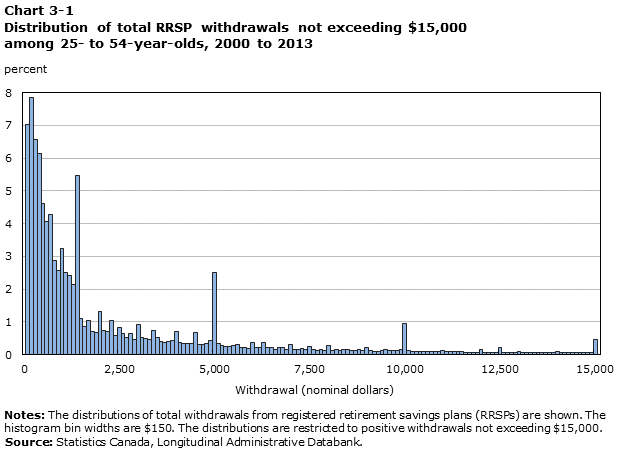
Description for Chart 3-1
| Bin | Distribution |
|---|---|
| percent | |
| 100 | 7.04 |
| 200 | 7.86 |
| 300 | 6.58 |
| 400 | 6.15 |
| 500 | 4.60 |
| 600 | 4.06 |
| 700 | 4.28 |
| 800 | 2.88 |
| 900 | 2.56 |
| 1,000 | 3.23 |
| 1,100 | 2.50 |
| 1,200 | 2.41 |
| 1,300 | 2.15 |
| 1,400 | 5.46 |
| 1,500 | 1.10 |
| 1,600 | 0.85 |
| 1,700 | 1.04 |
| 1,800 | 0.70 |
| 1,900 | 0.67 |
| 2,000 | 1.30 |
| 2,100 | 0.74 |
| 2,200 | 0.72 |
| 2,300 | 1.03 |
| 2,400 | 0.59 |
| 2,500 | 0.82 |
| 2,600 | 0.64 |
| 2,700 | 0.53 |
| 2,800 | 0.65 |
| 2,900 | 0.46 |
| 3,000 | 0.93 |
| 3,100 | 0.51 |
| 3,200 | 0.50 |
| 3,300 | 0.47 |
| 3,400 | 0.74 |
| 3,500 | 0.53 |
| 3,600 | 0.39 |
| 3,700 | 0.37 |
| 3,800 | 0.40 |
| 3,900 | 0.44 |
| 4,000 | 0.71 |
| 4,100 | 0.36 |
| 4,200 | 0.34 |
| 4,300 | 0.33 |
| 4,400 | 0.33 |
| 4,500 | 0.67 |
| 4,600 | 0.30 |
| 4,700 | 0.31 |
| 4,800 | 0.35 |
| 4,900 | 0.42 |
| 5,000 | 2.51 |
| 5,100 | 0.33 |
| 5,200 | 0.27 |
| 5,300 | 0.26 |
| 5,400 | 0.24 |
| 5,500 | 0.28 |
| 5,600 | 0.30 |
| 5,700 | 0.22 |
| 5,800 | 0.21 |
| 5,900 | 0.20 |
| 6,000 | 0.36 |
| 6,100 | 0.21 |
| 6,200 | 0.22 |
| 6,300 | 0.36 |
| 6,400 | 0.22 |
| 6,500 | 0.22 |
| 6,600 | 0.17 |
| 6,700 | 0.21 |
| 6,800 | 0.21 |
| 6,900 | 0.17 |
| 7,000 | 0.30 |
| 7,100 | 0.16 |
| 7,200 | 0.17 |
| 7,300 | 0.17 |
| 7,400 | 0.15 |
| 7,500 | 0.25 |
| 7,600 | 0.15 |
| 7,700 | 0.14 |
| 7,800 | 0.17 |
| 7,900 | 0.13 |
| 8,000 | 0.28 |
| 8,100 | 0.13 |
| 8,200 | 0.14 |
| 8,300 | 0.13 |
| 8,400 | 0.14 |
| 8,500 | 0.15 |
| 8,600 | 0.11 |
| 8,700 | 0.11 |
| 8,800 | 0.14 |
| 8,900 | 0.14 |
| 9,000 | 0.20 |
| 9,100 | 0.11 |
| 9,200 | 0.10 |
| 9,300 | 0.10 |
| 9,400 | 0.12 |
| 9,500 | 0.14 |
| 9,600 | 0.11 |
| 9,700 | 0.11 |
| 9,800 | 0.12 |
| 9,900 | 0.15 |
| 10,000 | 0.94 |
| 10,100 | 0.13 |
| 10,200 | 0.11 |
| 10,300 | 0.10 |
| 10,400 | 0.09 |
| 10,500 | 0.10 |
| 10,600 | 0.09 |
| 10,700 | 0.09 |
| 10,800 | 0.08 |
| 10,900 | 0.09 |
| 11,000 | 0.13 |
| 11,100 | 0.08 |
| 11,200 | 0.10 |
| 11,300 | 0.10 |
| 11,400 | 0.08 |
| 11,500 | 0.08 |
| 11,600 | 0.07 |
| 11,700 | 0.07 |
| 11,800 | 0.07 |
| 11,900 | 0.07 |
| 12,000 | 0.16 |
| 12,100 | 0.07 |
| 12,200 | 0.07 |
| 12,300 | 0.07 |
| 12,400 | 0.07 |
| 12,500 | 0.22 |
| 12,600 | 0.07 |
| 12,700 | 0.06 |
| 12,800 | 0.06 |
| 12,900 | 0.06 |
| 13,000 | 0.11 |
| 13,100 | 0.06 |
| 13,200 | 0.06 |
| 13,300 | 0.06 |
| 13,400 | 0.07 |
| 13,500 | 0.07 |
| 13,600 | 0.07 |
| 13,700 | 0.05 |
| 13,800 | 0.06 |
| 13,900 | 0.05 |
| 14,000 | 0.09 |
| 14,100 | 0.05 |
| 14,200 | 0.05 |
| 14,300 | 0.05 |
| 14,400 | 0.06 |
| 14,500 | 0.07 |
| 14,600 | 0.05 |
| 14,700 | 0.05 |
| 14,800 | 0.05 |
| 14,900 | 0.08 |
| 15,000 | 0.46 |
|
Notes: The distributions of total withdrawals from registered retirement savings plans (RRSPs) are shown. The histogram bin widths are $150. The distributions are restricted to positive withdrawals not exceeding $15,000. The withdrawals are in nominal dollars. Source: Statistics Canada, Longitudinal Administrative Databank. |
|
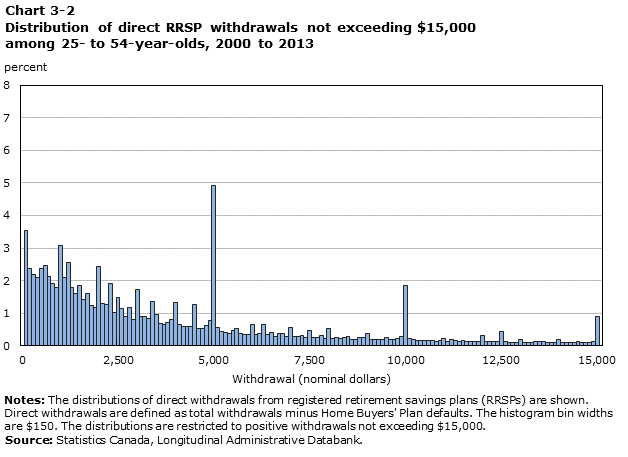
Description for Chart 3-2
| Bin | Distribution |
|---|---|
| percent | |
| 100 | 3.53 |
| 200 | 2.36 |
| 300 | 2.18 |
| 400 | 2.10 |
| 500 | 2.38 |
| 600 | 2.47 |
| 700 | 2.12 |
| 800 | 1.92 |
| 900 | 1.80 |
| 1,000 | 3.08 |
| 1,100 | 2.09 |
| 1,200 | 2.55 |
| 1,300 | 1.79 |
| 1,400 | 1.59 |
| 1,500 | 1.86 |
| 1,600 | 1.42 |
| 1,700 | 1.61 |
| 1,800 | 1.23 |
| 1,900 | 1.17 |
| 2,000 | 2.42 |
| 2,100 | 1.31 |
| 2,200 | 1.27 |
| 2,300 | 1.90 |
| 2,400 | 1.00 |
| 2,500 | 1.48 |
| 2,600 | 1.13 |
| 2,700 | 0.90 |
| 2,800 | 1.17 |
| 2,900 | 0.81 |
| 3,000 | 1.73 |
| 3,100 | 0.91 |
| 3,200 | 0.89 |
| 3,300 | 0.83 |
| 3,400 | 1.36 |
| 3,500 | 0.96 |
| 3,600 | 0.68 |
| 3,700 | 0.64 |
| 3,800 | 0.72 |
| 3,900 | 0.79 |
| 4,000 | 1.33 |
| 4,100 | 0.63 |
| 4,200 | 0.60 |
| 4,300 | 0.58 |
| 4,400 | 0.58 |
| 4,500 | 1.27 |
| 4,600 | 0.53 |
| 4,700 | 0.53 |
| 4,800 | 0.62 |
| 4,900 | 0.76 |
| 5,000 | 4.91 |
| 5,100 | 0.56 |
| 5,200 | 0.42 |
| 5,300 | 0.40 |
| 5,400 | 0.38 |
| 5,500 | 0.47 |
| 5,600 | 0.52 |
| 5,700 | 0.36 |
| 5,800 | 0.35 |
| 5,900 | 0.33 |
| 6,000 | 0.66 |
| 6,100 | 0.35 |
| 6,200 | 0.38 |
| 6,300 | 0.65 |
| 6,400 | 0.34 |
| 6,500 | 0.39 |
| 6,600 | 0.29 |
| 6,700 | 0.38 |
| 6,800 | 0.37 |
| 6,900 | 0.29 |
| 7,000 | 0.55 |
| 7,100 | 0.27 |
| 7,200 | 0.29 |
| 7,300 | 0.31 |
| 7,400 | 0.26 |
| 7,500 | 0.46 |
| 7,600 | 0.26 |
| 7,700 | 0.24 |
| 7,800 | 0.30 |
| 7,900 | 0.23 |
| 8,000 | 0.53 |
| 8,100 | 0.23 |
| 8,200 | 0.25 |
| 8,300 | 0.22 |
| 8,400 | 0.25 |
| 8,500 | 0.27 |
| 8,600 | 0.20 |
| 8,700 | 0.19 |
| 8,800 | 0.25 |
| 8,900 | 0.25 |
| 9,000 | 0.38 |
| 9,100 | 0.19 |
| 9,200 | 0.18 |
| 9,300 | 0.18 |
| 9,400 | 0.20 |
| 9,500 | 0.26 |
| 9,600 | 0.20 |
| 9,700 | 0.20 |
| 9,800 | 0.22 |
| 9,900 | 0.27 |
| 10,000 | 1.84 |
| 10,100 | 0.23 |
| 10,200 | 0.18 |
| 10,300 | 0.16 |
| 10,400 | 0.15 |
| 10,500 | 0.17 |
| 10,600 | 0.15 |
| 10,700 | 0.15 |
| 10,800 | 0.14 |
| 10,900 | 0.15 |
| 11,000 | 0.23 |
| 11,100 | 0.14 |
| 11,200 | 0.18 |
| 11,300 | 0.17 |
| 11,400 | 0.12 |
| 11,500 | 0.15 |
| 11,600 | 0.12 |
| 11,700 | 0.12 |
| 11,800 | 0.12 |
| 11,900 | 0.12 |
| 12,000 | 0.30 |
| 12,100 | 0.12 |
| 12,200 | 0.12 |
| 12,300 | 0.13 |
| 12,400 | 0.12 |
| 12,500 | 0.42 |
| 12,600 | 0.12 |
| 12,700 | 0.10 |
| 12,800 | 0.11 |
| 12,900 | 0.10 |
| 13,000 | 0.20 |
| 13,100 | 0.10 |
| 13,200 | 0.10 |
| 13,300 | 0.10 |
| 13,400 | 0.12 |
| 13,500 | 0.12 |
| 13,600 | 0.13 |
| 13,700 | 0.09 |
| 13,800 | 0.11 |
| 13,900 | 0.09 |
| 14,000 | 0.18 |
| 14,100 | 0.09 |
| 14,200 | 0.08 |
| 14,300 | 0.09 |
| 14,400 | 0.10 |
| 14,500 | 0.13 |
| 14,600 | 0.09 |
| 14,700 | 0.09 |
| 14,800 | 0.10 |
| 14,900 | 0.14 |
| 15,000 | 0.90 |
|
Notes: The distributions of direct withdrawals from registered retirement savings plans (RRSPs) are shown. Direct withdrawals are defined as total withdrawals minus Home Buyers' Plan defaults. The histogram bin widths are $150. The distributions are restricted to positive withdrawals not exceeding $15,000. The withdrawals are in nominal dollars. Source: Statistics Canada, Longitudinal Administrative Databank. |
|
The significant level of bunching seen here is not surprising—especially compared with related studies on sorting around tax discontinuities (Saez 2010; Kleven and Waseem 2013)—because of the high degree of salience of RRSP withholding-tax rates and individuals’ ability to precisely control how much they withdraw. In addition, the rates outlined in Table 2 are average (not marginal) withholding-tax rates, so there are large infra-marginal effects of withdrawing slightly above $5,000 or $15,000 on the amount of funds available for consumption as compared to withdrawing at or slightly below these thresholds.Note 7
Charts 3-1 and 3-2 also show several other types of sorting responses. First, the large spike in the distribution between $1,300 and $1,400 appears for total withdrawals but not direct withdrawals, resulting from HBP defaults on repayments. Comparing the two charts, a large mass of withdrawals at the bottom of the distribution evidently occurs for this reason. In addition, there are small bumps in the distribution at various points, especially below $5,000, likely reflecting the fact that individuals often elect to withdraw in round numbers. The spike at $10,000, despite there being no discontinuity in the withholding-tax schedule at this threshold, may arise because of round-number bias or from individuals making multiple withdrawals of smaller amounts, perhaps across plans or financial institutions, to strategically avoid the higher withholding-tax rate.
Overall, these findings provide new insight into an important determinant of RRSP withdrawal behaviour. Since tax withholding is not a final tax or penalty on withdrawing and has a negligible effect on lifetime wealth and tax liabilities, the extent to which RRSP withdrawals should respond to a change in the withholding-tax rate is unclear. An implication of the life-cycle theory is that consumption and savings do not respond to predictable changes in income (Souleles 1999). However, previous studies show that predictable changes in income caused by tax rebates, refunds, the timing of paycheck receipt, and tax withholding all have large effects on household consumption and savings decisions (Shapiro and Slemrod 1995; Souleles 1999; Johnson, Parker and Souleles 2006; Stephens 2006; Feldman 2010; Jones 2012; LaLumia 2013). The result that RRSP withdrawals appear to respond significantly to tax withholding suggests that the (sub-annual) timing of income tax payments can have a real bearing on savings and withdrawal behaviour.
RRSP versus TFSA use: A comparison across income groups
The introduction of TFSAs in 2009 changed the menu of tax-preferred savings vehicles available to Canadians. Contributions to TFSAs are made with after-tax income, but investment income accrues on a tax-free basis, and income drawn from the accounts is not subject to income tax.
The relative advantage of RRSPs compared with TFSAs depends on many factors. Among low-income individuals, RRSPs offer a weak incentive to save given that contributors’ marginal tax rates are already low. In addition, RRSP distributions in retirement crowd out public pension benefit entitlements—specifically, the Guaranteed Income Supplement (GIS)—whereas the same is not true of TFSA distributions. Taken together, lower-income individuals may be expected to substitute TFSAs for RRSPs upon the introduction of the former, unless such factors as inertia or financial illiteracy deter individuals from responding in this manner.
In contrast, for higher-income individuals, RRSPs offer a significant tax advantage, and crowding-out of the GIS is less of a concern. However, higher-income individuals tend to be more educated and financially literate than those with lower incomes (Lusardi and Mitchell 2010; Mullock and Turcotte 2012) and may be more likely to earn above-market investment returns (Calvet, Campbell and Sodini 2009; Lusardi, Michaud and Mitchell 2013). These individuals may therefore have a greater demand for TFSAs so that they can avoid incurring taxes on this income. RRSPs and TFSAs may also be very complementary in practice, to the extent that individuals use these plans for different underlying reasons or their contribution limits to these plans are binding constraints on how much they can actually save.Note 8
Chart 4 considers the incidence of contributing to RRSPs and TFSAs for 25- to 54-year-olds across income quartiles, from 2009 to 2013. Importantly, the values represent the likelihood of contributing in a given year rather than the probability of holding assets in these accounts, although the two are correlated. The results show that the incidence of saving in tax-preferred accounts increases with income, from 9% in the bottom quartile to nearly 60% at the top. This finding likely reflects a range of factors. While low-income individuals tend to have less disposable income available for saving, their dependence on private savings in retirement is also lower given that public pensions replace a declining percentage of earnings as earnings increase. Thus, private retirement savings needs increase with earnings in order to obtain a target income replacement rate in retirement. The results also show that the relative take-up rate of TFSAs compared to RRSPs decreases with income. The bottom quartile is approximately 3.9 times more likely to contribute to a TFSA than an RRSP, but this ratio falls to 0.8 for the low-middle income group and to 0.4 for the high-middle and high income groups.

Description for Chart 4
| Incidence | Low income | Low-middle income | High-middle income | High income | ||||||||
|---|---|---|---|---|---|---|---|---|---|---|---|---|
| RRSP | TFSA | Either | RRSP | TFSA | Either | RRSP | TFSA | Either | RRSP | TFSA | Either | |
| percent | ||||||||||||
| 2.0 | 7.8 | 9.0 | 15.3 | 12.2 | 23.1 | 36.7 | 15.8 | 42.5 | 55.4 | 22.3 | 59.9 | |
|
Notes: Income groups are based on total income quartiles. The data on registered retirement savings plan (RRSP) and tax-free savings account (TFSA) use are restricted to the years 2009 to 2013, since TFSAs were not established before this time. For both types of accounts, an individual is deemed to be a "contributor" if positive net contributions were made in the reference year. In other words, individuals who may have contributed but also withdrew a larger amount are not counted. The RRSP withdrawals include the defaults on Home Buyers' Plan repayments. Source: Statistics Canada, Longitudinal Administrative Databank. |
||||||||||||
RRSP versus TFSA use: A longitudinal analysis
This section considers how net savings contributions (defined as contributions minus withdrawals) to RRSPs responded to the introduction of TFSAs, in a longitudinal research design. The analysis centres on two different types of individuals who have revealed preferences for tax-preferred savings (i.e., whose observed behaviour indicates that they have a demand for savings accounts that provide tax incentives to contribute).
The first type is individuals who had positive net savings in an RRSP at least once from 2005 to 2008, henceforth referred to as “RRSP users” for simplicity. This group has revealed a demand for tax-preferred savings based on their utilization of RRSPs, which makes considering how their RRSP contribution and withdrawal decisions responded to the introduction of TFSAs particularly informative.
The second type of individuals with a revealed preference for tax-preferred savings is those who had positive net savings in TFSAs at least once, from 2009 to 2013, referred to as “TFSA users” for simplicity. This group has revealed a demand for tax-preferred savings based on their use of TFSAs rather than RRSPs. While these individuals may or may not have used RRSPs prior to the introduction of TFSAs, a lack of such usage cannot be interpreted as a lack of demand for tax-preferred savings. Such behaviour may instead reflect the fact that their desired form of savings account had not been created yet. For this reason, considering how usage of RRSPs among TFSA users was affected by the introduction of TFSAs is also informative.
Charts 5-1 and 5-2 show the incidence of contributing to an RRSP or TFSA and the average values of these net contributions, respectively, among RRSP users. The chart also delineates individuals based on their total incomes relative to the median in 2013 constant dollars, using the median value computed for the pooled dataset spanning the years 2005 to 2013. Consistent with the previous findings, savings rates are higher among the at-or-above median income group, but substitution from RRSPs to TFSAs is more prevalent for the below median income group. In particular, below median income RRSP users became nearly 45% less likely to save in RRSPs from 2008 to 2013, whereas at-or-above median income RRSP users became only approximately 16% less likely to do so. The average value of RRSP savings among below median income RRSP users fell from $800 in 2008 to only $100 in 2013. While such trends could also be explained by the onset of the economic recession around this period, the fact that the sum of total savings in RRSPs and TFSAs did not decline (and actually increased for the higher-income group) suggests that the recession is not driving this effect.
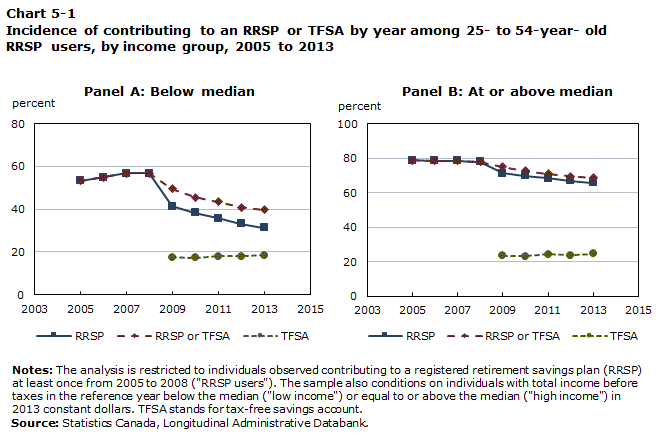
Description for Chart 5-1
| Year | Below median | At or above median | ||||
|---|---|---|---|---|---|---|
| RRSP | TFSA | RRSP or TFSA | RRSP | TFSA | RRSP or TFSA | |
| percent | ||||||
| 2005 | 53.3 | Note ...: not applicable | 53.3 | 79.0 | Note ...: not applicable | 79.0 |
| 2006 | 54.9 | Note ...: not applicable | 54.9 | 78.6 | Note ...: not applicable | 78.6 |
| 2007 | 56.8 | Note ...: not applicable | 56.8 | 78.7 | Note ...: not applicable | 78.7 |
| 2008 | 56.9 | Note ...: not applicable | 56.9 | 78.0 | Note ...: not applicable | 78.0 |
| 2009 | 41.5 | 17.6 | 49.6 | 71.5 | 23.3 | 75.2 |
| 2010 | 38.3 | 17.3 | 45.7 | 69.9 | 23.2 | 72.9 |
| 2011 | 35.8 | 18.1 | 43.5 | 68.4 | 24.2 | 71.2 |
| 2012 | 33.1 | 18.0 | 40.9 | 66.9 | 23.6 | 69.6 |
| 2013 | 31.4 | 18.5 | 39.7 | 65.8 | 24.7 | 68.7 |
|
... not applicable Notes: The analysis is restricted to individuals observed contributing to a registered retirement savings plan (RRSP) at least once from 2005 to 2008 ("RRSP users"). The sample also conditions on individuals with total income before taxes in the reference year below the median ("low income") or equal to or above the median ("high income") in 2013 constant dollars. TFSA stands for tax-free savings account. Source: Statistics Canada, Longitudinal Administrative Databank. |
||||||
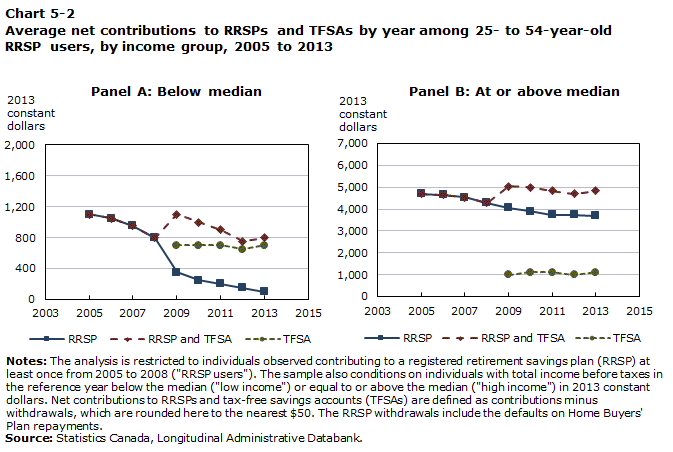
Description for Chart 5-2
| Year | Below median | At or above median | ||||
|---|---|---|---|---|---|---|
| RRSP | TFSA | RRSP and TFSA | RRSP | TFSA | RRSP and TFSA | |
| 2013 constant dollars | ||||||
| 2005 | 1,100 | Note ...: not applicable | 1,100 | 4,700 | Note ...: not applicable | 4,700 |
| 2006 | 1,050 | Note ...: not applicable | 1,050 | 4,650 | Note ...: not applicable | 4,650 |
| 2007 | 950 | Note ...: not applicable | 950 | 4,550 | Note ...: not applicable | 4,550 |
| 2008 | 800 | Note ...: not applicable | 800 | 4,300 | Note ...: not applicable | 4,300 |
| 2009 | 350 | 700 | 1,100 | 4,050 | 1,000 | 5,050 |
| 2010 | 250 | 700 | 1,000 | 3,900 | 1,100 | 5,000 |
| 2011 | 200 | 700 | 900 | 3,750 | 1,100 | 4,850 |
| 2012 | 150 | 650 | 750 | 3,750 | 1,000 | 4,700 |
| 2013 | 100 | 700 | 800 | 3,700 | 1,100 | 4,850 |
|
... not applicable Notes: The analysis is restricted to individuals observed contributing to a registered retirement savings plan (RRSP) at least once from 2005 to 2008 ("RRSP users"). The sample also conditions on individuals with total income before taxes in the reference year below the median ("low income") or equal to or above the median ("high income") in 2013 constant dollars. Net contributions to RRSPs and tax-free savings accounts (TFSAs) are defined as contributions minus withdrawals, which are rounded here to the nearest $50. The RRSP withdrawals include the defaults on Home Buyers' Plan repayments. Source: Statistics Canada, Longitudinal Administrative Databank. |
||||||
In contrast, little substitution is observed for either income group among TFSA users, who may or may not have saved at all in RRSPs prior to 2009, as shown in Charts 6-1 and 6-2. Among the below median income group, contributing to a tax-preferred savings plan increased by over 35 percentage points from 2008 to 2013—coinciding with the introduction of TFSAs—while saving in RRSPs fell by only approximately 3 percentage points. The low degree of substitution seen here may in part stem from participation rates in RRSPs being low to begin with. Similarly, little substitution is observed among the at-or-above median income group, as the incidence of contributing to an RRSP or TFSA increased by approximately 14% from 2008 to 2013, whereas RRSP contributions declined by only 8%. The introduction of TFSAs likely prompted many individuals to use tax-preferred savings accounts who were not doing so regularly in the past, although the extent to which this led to new savings rather than redistribution from taxable accounts is outside the scope of this study and remains an important topic for future research.
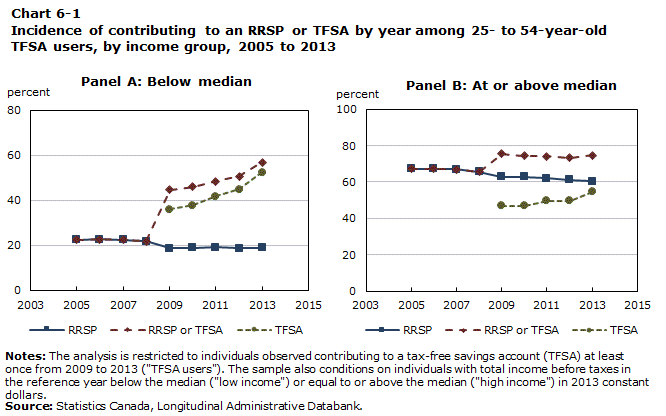
Description for Chart 6-1
| Year | Below median | At or above median | ||||
|---|---|---|---|---|---|---|
| RRSP | TFSA | RRSP or TFSA | RRSP | TFSA | RRSP or TFSA | |
| percent | ||||||
| 2005 | 22.4 | Note ...: not applicable | 22.4 | 67.4 | Note ...: not applicable | 67.4 |
| 2006 | 22.6 | Note ...: not applicable | 22.6 | 67.4 | Note ...: not applicable | 67.4 |
| 2007 | 22.4 | Note ...: not applicable | 22.4 | 67.0 | Note ...: not applicable | 67.0 |
| 2008 | 21.8 | Note ...: not applicable | 21.8 | 65.7 | Note ...: not applicable | 65.7 |
| 2009 | 18.6 | 36.0 | 44.7 | 62.9 | 46.9 | 75.6 |
| 2010 | 19.0 | 37.8 | 45.9 | 62.9 | 47.0 | 74.5 |
| 2011 | 19.1 | 41.7 | 48.5 | 62.1 | 49.6 | 74.2 |
| 2012 | 18.8 | 44.8 | 50.7 | 61.1 | 49.7 | 73.3 |
| 2013 | 19.0 | 52.4 | 56.9 | 60.5 | 54.6 | 74.6 |
|
... not applicable Notes: The analysis is restricted to individuals observed contributing to a tax-free savings account (TFSA) at least once from 2009 to 2013 ("TFSA users"). The sample also conditions on individuals with total income before taxes in the reference year below the median ("low income") or equal to or above the median ("high income") in 2013 constant dollars. Source: Statistics Canada, Longitudinal Administrative Databank. |
||||||
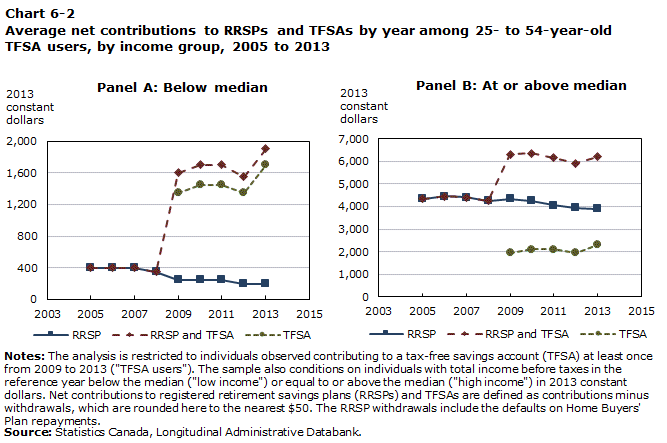
Description for Chart 6-2
| Year | Below median | At or above median | ||||
|---|---|---|---|---|---|---|
| RRSP | TFSA | RRSP and TFSA | RRSP | TFSA | RRSP and TFSA | |
| 2013 constant dollars | ||||||
| 2005 | 400 | Note ...: not applicable | 400 | 4,350 | Note ...: not applicable | 4,350 |
| 2006 | 400 | Note ...: not applicable | 400 | 4,450 | Note ...: not applicable | 4,450 |
| 2007 | 400 | Note ...: not applicable | 400 | 4,400 | Note ...: not applicable | 4,400 |
| 2008 | 350 | Note ...: not applicable | 350 | 4,250 | Note ...: not applicable | 4,250 |
| 2009 | 250 | 1,350 | 1,600 | 4,350 | 1,950 | 6,300 |
| 2010 | 250 | 1,450 | 1,700 | 4,250 | 2,100 | 6,350 |
| 2011 | 250 | 1,450 | 1,700 | 4,050 | 2,100 | 6,150 |
| 2012 | 200 | 1,350 | 1,550 | 3,950 | 1,950 | 5,900 |
| 2013 | 200 | 1,700 | 1,900 | 3,900 | 2,300 | 6,200 |
|
... not applicable Notes: The analysis is restricted to individuals observed contributing to a tax-free savings account (TFSA) at least once from 2009 to 2013 ("TFSA users"). The sample also conditions on individuals with total income before taxes in the reference year below the median ("low income") or equal to or above the median ("high income") in 2013 constant dollars. Net contributions to registered retirement savings plans (RRSPs) and TFSAs are defined as contributions minus withdrawals, which are rounded here to the nearest $50. The RRSP withdrawals include the defaults on Home Buyers' Plan repayments. Source: Statistics Canada, Longitudinal Administrative Databank. |
||||||
Conclusion
This article documents recent trends in registered retirement savings plan (RRSP) use among taxfilers aged 25 to 54, from 2000 to 2013, focusing on differences across income groups, around the time that tax-free savings accounts (TFSAs) were introduced.
Overall, the flow of funds into RRSPs has declined in recent years. Whether this trend results from such factors as the recent economic recession, shifts toward other means of wealth accumulation—including home equity, TFSAs or taxable savings—or other reasons altogether is an open question. However, pre-retirement RRSP withdrawals correlate with several indicators of financial hardship, namely receipt of Employment Insurance and social assistance, and they are also responsive to withholding taxes. In addition, the demand for RRSPs appears to differ, as expected, for individuals based on their levels of total income, as evidenced across income groups by different patterns of substitution from RRSPs to TFSAs since the introduction of TFSAs in 2009. Taken together, it is likely that RRSPs are sometimes used for reasons other than retirement savings, although much of taxfilers’ deposits will probably remain in their RRSPs until retirement.
References
Akyeampong, E.B. 1998. “RRSP contributions and withdrawals: An update.” Perspectives on Labour and Income 10 (1): 29–33. Statistics Canada Catalogue no. 75-001-XPE.
Calvet, L., J. Campbell, and P. Sodini. 2009. “Measuring the financial sophistication of households.” American Economic Review 99 (2): 393–398.
Feldman, N.E. 2010. “Mental accounting effects of income tax shifting.” The Review of Economics and Statistics 92 (1): 70–86.
Frenken, H. 1996. “RRSP withdrawals revisited.” Perspectives on Labour and Income 8 (4): 16–19. Statistics Canada Catalogue no. 75-001-XPE.
Frenken, H. 1997. “Low incomes and RRSPs.” Perspectives on Labour and Income 9 (1): 46–47. Statistics Canada Catalogue no. 75-001-XPE.
Frenken, H. 1998. “Tapping unused RRSP room.” Perspectives on Labour and Income 10 (1): 34–37. Statistics Canada Catalogue no. 75-001-XPE.
Giles, P., and K. Maser. 2004. “Using RRSPs before retirement.” Perspectives on Labour and Income 5 (12): 14–22. Statistics Canada Catalogue no. 75-001-XIE.
Johnson, D.S., J.A. Parker, and N.S. Souleles. 2006. “Household expenditure and the income tax rebates of 2001.” American Economic Review 96 (5): 1589–1610.
Jones, D. 2012. “Inertia and overwithholding: Explaining the prevalence of income tax refunds.” American Economic Journal: Economic Policy 4 (1): 158–185.
Kleven, H.J., and M. Waseem. 2013. “Using notches to uncover optimization frictions and structural elasticities: Theory and evidence from Pakistan.” The Quarterly Journal of Economics 128 (2): 669–723.
LaLumia, S. 2013. “The EITC, tax refunds, and unemployment spells.” American Economic Journal: Economic Policy 5 (2): 188–221.
Lusardi, A., P.-C. Michaud, and O.S. Mitchell. 2013. Optimal financial knowledge and wealth inequality. Working Paper Series 18669. Cambridge, Massachusetts: National Bureau of Economic Research.
Lusardi, A., and O.S. Mitchell. 2010. How ordinary consumers make complex economic decisions: Financial literacy and retirement readiness. CFS Working Paper Series 2010/11. Frankfurt: Center for Financial Studies.
Mawani, A., and S. Paquette. 2011. “Pre-retirement RRSP withdrawals.” Canadian Tax Journal 59 (2): 183–219.
Messacar, D. 2015. Do workplace pensions crowd out other retirement savings? Evidence from Canadian tax records. Analytical Studies Branch Research Paper Series, no. 371. Statistics Canada Catalogue no. 11F0019M. Ottawa: Statistics Canada.
Messacar, D.R.J. 2016. Three Essays on the Behavioural Economics of Saving for Retirement. Toronto: Department of Economics, University of Toronto. Permanent link: http://hdl.handle.net/1807/73045.
Mullock, K., and J. Turcotte. 2012. Financial literacy and retirement savings. Department of Finance Canada Working Paper 2012-01. Ottawa: Department of Finance.
Saez, E. 2010. “Do taxpayers bunch at kink points?” American Economic Journal: Economic Policy 2 (3): 180–212.
Shapiro, M.D., and J. Slemrod. 1995. “Consumer response to the timing of income: Evidence from a change in tax withholding.” American Economic Review 85 (1): 274–283.
Souleles, N.S. 1999. “The response of household consumption to income tax refunds.” American Economic Review 89 (4): 947–958.
Steele, M. 2007. “The Canadian Home Buyers’ Plan: Tax benefit, tax expenditure, and policy assessment.” Canadian Tax Journal 55 (1): 1–30.
Stephens, M., Jr. 2006. “Paycheck receipt and the timing of consumption.” The Economic Journal 116 (513): 680–701.
Veall, M. 2001. “Did tax flattening affect RRSP contributions?” Canadian Journal of Economics 34 (1): 120–131.
Notes
- Date modified:

